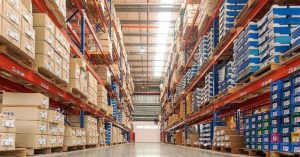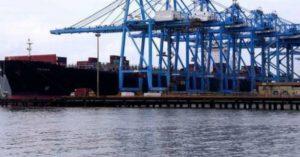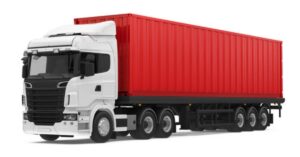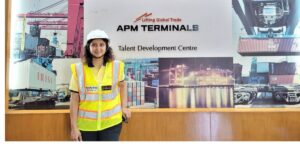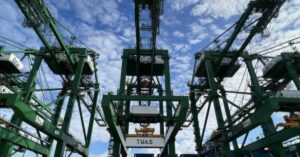At the beginning of the year, you were 10% per annum growth for CONCOR. So, when you look back how has been the situation?
Growth is very good. Actually, in the last seven years, we had all the balance sheets every quarter they were better than the previous quarter. The growth was going on and we picked up the growth from 2017 onwards very well. But unfortunately, two-years of Covid has put a break on this. Particularly the two quarters of covid that affected very badly with entire shutdowns and all those negative effects have put a little break on our growth. But after six months of Covid in the second phase of Covid we started getting V-shaped recovery. Last year we had a good growth as we touched Rs 8,500 crores and this year also the growth is continuing. I am sure that the growth will continue for the time being, because I am not seeing any changes in the sector where we are on.
When we look at the numbers in terms of volumes where is the growth coming from? Can you give us an insight into domestic and EXIM cargoes?
The real logistics picture is coming out in our (CONCOR) growth story. As I always tell, for doing logistics India is the best market, we got 140 crore population, and where there is population there you can do a better logistics. We can create a very advanced logistics system, but when there is no population like when you go to a country like Sweden where the entire population is only 10 million what sort of logistics we can do. The limitations will come.
But here we have got major opportunities in align with that if we see in 2016 when I took over as CMD of CONCOR, the receipts from the EXIM operations used to be 80 per cent in our revenue side and from domestic it used to be 20 per cent. If you see last Year’s balance sheet it is 65 per cent from EXIM 35 per cent from domestic. So, it’s very obvious that domestic numbers are continuously increasing. The domestic growth rate was above 28 per cent a year before and last year in volume it was almost 18 per cent. There is lot of opportunity in domestic, because of the new solutions which we have brought in like business solutions, business support services, and bulk handling solutions. They got huge potential so the sky is the limit for domestic to grow. I put a target for myself and my team, we discussed it, we thought we will bring in domestic to 40 per cent and EXIM to 60 per cent before 2025. I think we are on the target as a company we will achieve that, and ultimately it will be 50-50 for domestic and EXIM cargo.
Let me come to the bulk handling solutions that you have mentioned. There are three very fascinating very innovative path-breaking solutions that you have designed one is bulk handling of cement, the second one is container as warehousing, and distributed logistics. Can you give us an insight into how these have taken off and how is the market acceptability?
First, I will start with bulk handling, we targeted first cement, because it is the toughest commodity to handle in bulk. There is resolution available for bulk handling, but then that is in a specialised container. So, any specialised stock the main problem is an inbuild empty run will be there. It will be one side loaded and one side empty. All of us know to carry out logistics in profitable manner both sides-loaded run is required. If you can reduce empty run as much as possible that much your profitability will increase. So, our solution is using normal GP containers using flexi bags so that once the cement is unloaded the container is available for any other goods. So, this solution we have targeted for cement, because in that particular method of evacuation cement is the toughest to evacuate. We could device a beautiful system, which is much more ecofriendly than how it is being carried currently. It is cost-effective as it saves a lot for cement manufacturers and its users. Cement is produced in bulk used in bulk but only carried in bags just because we don’t have the proper means to carry it in bulk. When we looked at market in cement, on the usage front customers can accept in bulk, almost 70 per cent of the customers can accept in bulk. The acceptability of the solution was very great as we could do almost 40,000 containers in the first year itself. We did in south from Jggayyapet to Arkonam and Tundiyapet and in the west from Udaipur to Bombay and Ankleshwar.
Presently, as we are rail-based operator, the railway tariff fixed by Indian Railways plays a major part in our solutions. There was some new thinking going on in Railways, I have discussed this and decision will come soon. Currently, we are on hold on bulk cement but the solution is fantastic and there is no doubt it is going to take up.
The solution is good because, the cement companies need not go for permanent infrastructure to develop their market. Container as a warehouse is also a part of this solution. Cement will be stored in containers and will be supplied directly from containers. If there is a bag cement market, they need not carry bagging equipment. We developed portable bagging equipment in the container, so where ever they are required it can bag up to 20 tonnes an hour. So, the entire solution is storage bagging and distribution. This solution is going to change the way cement logistics are done.
In container as warehousing, the idea is the goods when they stuffed in to container, they have to be stored into warehouse again. That intermediate handling requires three handlings unloading from container, loading on to a truck and unloading at warehouse, and again picking from warehouse and loading on to trucks for distribution. Every handling is cost as well as wastage, so what we proposed to our customers is to use containers as warehouse and pay us on a dynamic basis. As on date we fixed Rs 200 per day per usage. It’s very flexible operation, as one need not hire the container for a longer period. Suppose 90 containers a customer has to move he need not take any warehouse on rent. He is trying to establish a new market keep the goods in containers, we will directly distribute it from there itself. So again, the distribution logistics is merged with this container warehousing method. It is very advantageous for the merchants and wholesale traders and distributors. This has picked up very well and lot of new markets established something like the products soda and soda ash and some other industrial products where they don’t sell it at production point, they bring it to the consumption point and then try to market it. This method is giving lot of flexibility to the companies.
In terms of logistics for you moving the containers and relocating them is that a challenge?
No, we are into that operation, we move the container, we store the containers, our yards are there. So, our yards are used as warehouses instead of constructing permanent warehouses. Only challenge which has come to us is, after the Galwan incident, India put a ban on importing containers from China. India as a big country should develop our own container manufacturing capability. In this regard CONCOR has taken a lot of initiatives in this. I can proudly say the eco system is developing in India. On regular basis 600 to 700 containers are getting manufactured in India. India will be able to produce about 3,000 to 4,000 containers in a month.
At one point of time, we had this major challenge of relocating empty containers which bore a huge cost on the company. Any improvement done on this?
That was on the EXIM containers. There was a shortage in export import containers, so we gave a scheme. To encourage shipping lines to come to hinterland, we said we will give 50 per cent discount move the empty container to India. As CONCOR being a PSU profit is not the only motive, our motive is to serve the export importers if the country. So, this was very well appreciated by everyone and the Govt of India. Even now also we are running a scheme we call it one plus one scheme. We try to move empty containers free with one loaded container extra we get.
Let’s talk about digital initiatives you have taken in terms of improving operational efficiency how does they benefit CONCOR and also what do they mean for the customer?
I will start with a customer. All the digital initiatives started in the last seven years; the main focus is customer value creation. When I took over as Chairman of this company, the first thing I said to my team and all Concoreans that our quality policy is three words – its customer value creation. We must create value as much as possible for the customer. First, we started with KYCL – know your container location. It was the first digital initiative we have taken. It took us almost six months to bring it all over India, and it was very successful with the customers.
After that we brought in e-fling and along with it we brought e-office. Then we brought in e-billing for vendors and for the contractors. The company with Rs 8,500 crore annual turnover last year has only 1,320 employees. So, per employee turnover is more than Rs 6.5 crore. We are the most efficient compared to any PSU or even any company private sector in this sphere. All this is possible because we have digitised everything in our operations. No cheques are used for payment at our company, everything is done through electronic payment methods.
We have recently started a container terminal management system. It’s completely automated container terminal management system based on AIIM. This is now more or less testing is completed, and commercial has to come we are doing it at our flagship terminal at Tughlaquabad. Once it is proven we expand it all over. It is a video-based capturing of data, which we will make live to our customers soon.
How CONCOR is supporting trade in our neighbouring countries Nepal and Bangladesh?
We are carrying our operations continuously the containers are moved. All the third country cargo for Nepal from port we are moving and that with ECTS system has become efficient operation. In addition to that bilateral cargo also we are giving our own containers for Bangladesh and Nepal. In our domestic containers we carry the cargo to these two countries and the exporters are getting benefitted. In Bangladesh the Bangladesh Railway has got constraints, they can’t deal with more trains. They can’t receive more than three trains a day. Their railway system is not as efficient as ours, and to overcome that we have given a scheme to our exporters. We give our containers we move it up to the boarder if they require and from there, they can move it by any other mode can take the container into Bangladesh and bring it back or again like container warehousing charges we fix some charges.
Any investments into new infrastructure?
We are trying to make a balanced approach here. We are developing new terminals. New terminals this year one we have already completed and in the final stages at Kalinga Nagar. Our Paradip MMLP at the port side is fully operational now. We are also planning some more terminals in Delhi, Punjab, near Bombay and in Rajasthan. Continuously we are on the expansion mode.
We are also trying to develop some asset land models in the PPP mode, where the asset will be owned by private entrepreneur and we will provide all the systems and the procedures and marketing support.
The major investment in the next five years will be rolling stock. We ordered and our rolling stock programme is quite an impressive one. Last year with all that covid effects we added good number of rakes and this year we will be adding 30-40 rakes. There was some problem with wheels but we overcame all of that. Like containers, we have also developed ecosystem for wheel manufacturing also. Now wheels shortage has gone.
Any update on the disinvestment process which has been in limbo for long? As the Cabinet has also cleared the land licensing policy, so what’s next?
This is a billion-Dollar question everybody asks me; my answer is as of now it is in limbo and may continue. There is a clear divide in the business as well as in the government and that is why a very well-run profit-making PSU is to be privatised. I can’t comment on that because it’s a govt decision, so as of now yes divestment is still on, but not happening there is no movement at all. Myself and my team we forgot about it and we will carry on our own work, and we feel that we will be able to deliver the best in the industry even as a PSU.
You have grown within the ranks of this organisation; you are youngest and the longest serving CMD. How has been the experience with CONCOR? I had a very nice experience with CONCOR. May be without this I would not have achieved the personal satisfaction I have achieved. I could experiment with many new things right from the time I moved in to railways to CONCOR in 2002 from then onwards I was experimenting many things. Developed lot of terminals, designed new terminals, so all these experiences it wouldn’t have been possible without CONCOR. As a person also I think I got matured much working here. Heading this organisation for seven years has given lot of insight to me about the trade and industry of India, EXIM business and what not. My vision has really grown much beyond. I would have been a railway officer continued in railways where I joined, maybe I wouldn’t have achieved this much. I am very much satisfied, and in fact, we had some function yesterday which they named it as ‘Sunehre Yade’ (Golden Memories). I too have some golden memories with CONCOR.



